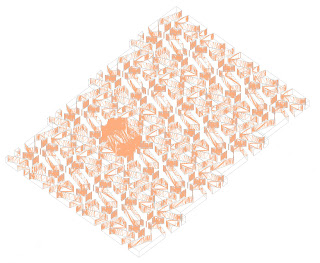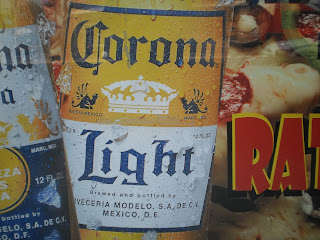Tuesday, December 13, 2011
Thursday, December 8, 2011
Tuesday, December 6, 2011
Concept
The creation of a linear gallery based on the tectonics and pattern of the inverse model of an image of bamboo poses the challenge of interpreting the media at different scales. I have analyzed the individual pieces of the original model, and I have abstracted the knuckle on the bamboo pieces so that it is an interpretation of two cylindrical parts colliding, and that force of collision creates a buckling so that the materials break away from the original form creating a greater circumference at the location of collision. I have used this concept to develop a parti that expresses a collision of two linear aspects that meet and then diverge because of the implied friction created by the act of colliding. In a literal sense, there are two linear galleries that collide, and on section slides underground, whereas the other is pushed upwards. In terms of the scale of the entire inverse model, the cylindrical tubes can be used as a screening system across the skin of the gallery. The screen can be selectively omitted in places to allow for a rhythm on the façade and to allow for more light to get in the gallery at opportune locations.
Tuesday, November 29, 2011
Exercise 10

For this exercise, I created several iterations for the logo of the Linear Gallery of the Architecture building. Most of the iterations stem from an abstraction of a plan view of the bays of the gallery.I have used squares to represent the bays and aligned them either vertically or horizontally and changed the text to achieve different effects. Later iterations (right) start to develop a three dimensional interpretation of the space with, either overlapping transparent rectangles, or solid blocks.
Tuesday, November 22, 2011
Exercise 9
Using the form-z representation of the bamboo image, I created a series of small models that explore the knuckle or ring on the stalks. I treated the phenomena as if two cylinders collided, and through that process the material begins to expand and bulge. I used this idea to create a physical model out of chip board.
Thursday, November 10, 2011
Exercise 8
For this exercise, I took the image of a texture (bamboo stalks) and a space (Frank Gehry's Guggenheim Museum) and abstractly modeled them on Form-Z. The bamboo is broken up into three layers: the stalks, the connection pieces, and small tubes of white that represent the highlights on the texture of the bamboo on the original photo. The museum space is broken up into the transparent background with an abstraction of mullions, curvy walls that stretch up to the ceiling, and solid cylinders that represent the walls that meet the ground plane. In both sets of images, the natural light provides little contrast. The spotlights are located within the models and therefore create a different sense of depth. The hybrid lighting conditions have a greater sense of contrast.
Thursday, November 3, 2011
Portfolio Intentions
While creating the layouts for the portfolio spreads and resume, it was my intention to create a grid of datum lines that can be utilized throughout the portfolio. The grid consists of a bar on the top that can house the title, process models, diagrams, etc. The bar allows for a progression of ideas to flow from page to page. There is a bar on the bottom as well, and this bar can house grounded images such as elevations or sections. The center is split into two columns. These areas can be combined to create more hierarchical areas.
Thursday, October 27, 2011
Exercise 7
For this exercise I further developed my skills in Form Z by creating a realistic model of a bay in the linear gallery of the architecture school. My intentions for the perspective were to give the model a human scale by adding scale figures, show that the bay is repeated in the linear gallery by shrinking the perspective and repeating it along the axis of the gallery, and show the context of the gallery by showing the relationship of the room with the exterior.
Thursday, October 13, 2011
Project 1 final
Through analysis of a gothic typeface, specifically the letter O, I have created a composition that describes the formal make-up of the letter and utilizes a three dimensional model to tie in my discoveries to the original two dimensional base. The letter is made of two identical pieces that are split at the line of the stress of the letter. If one of the pieces is rotated and shifted it completes the origin letter. The two dimensional pattern is a diagram of that rotation, and the three dimensional model is an extrusion of the parts of the pattern so that the individual parts are rotating up and around a central tower; of which, the cross-section is composed of the letter O.
Monday, October 10, 2011
Exercise 6
For the exercise, I have edited the previous project. First, I spread the O towers apart so that the viewer can understand the space in between the model. The model deteriorates into hidden frame instead of the less clear wireframe. A ghosted close-up perspective is on the right and on top is the progression from the base letter to the pattern. Light dashed lines connect a series of the base letters so that the rhythm of the progression is clear.
Tuesday, October 4, 2011
Exercise 5
For this exercise, I continued to show the symmetrical quality of the letter O by breaking the letter into two equal parts and rotating them. Still using the 2d pattern created on illustrator, I created a different 3d pattern than the last exercise. This new model better shows the rotational quality of parts of the letter because they spiral up and around the base form, which is highlighted in orange. The bottom of the model disintegrates into the wireframe, revealing the spiral on which the part is rotated. On the left side of the image, is a series of images that show the process of creating the form, starting with the letter, moving to the pattern, then the model.
Tuesday, September 27, 2011
axon rendered 2
 Using the O pattern created on Illustrator, which focused on the rotation of parts that create a new letter on the stress line, I have emphasized the negative space by making it a solid figure. In the center of the plane, I have created hierarchy by building a single figure of the original base. The second iteration focuses on the juxtaposition of the positive and negative space and how the two entities connect.
Using the O pattern created on Illustrator, which focused on the rotation of parts that create a new letter on the stress line, I have emphasized the negative space by making it a solid figure. In the center of the plane, I have created hierarchy by building a single figure of the original base. The second iteration focuses on the juxtaposition of the positive and negative space and how the two entities connect. Tuesday, September 20, 2011
Pattern 1 exercise 3
This pattern is an analysis of the transformative process that creates the letter A and a comparison of the the rectilinear and curvilinear shapes that make up the letter. From the middle, the letter starts as a block and as it moves outward, portions are carved away until the letter stands on its own. The reflection of the transformation allows for a pattern of the negative space. However, because the composition is a line drawing, the figure and ground are up to the viewer's opinions; therefore, the aforementioned negative space can become interesting figures on the sides of the drawing.
Pattern 2 Exercise 3
For this pattern, I isolated a single letter, and split the O into two parts. The parts are rotated in a transparent layer until it completes another O below or above the original O. This analysis explores how two parts of the letter are a the same and make a complete letter after rotation. Also, the diagonal alignment of the O's is an analysis of the line of stress.
Tuesday, September 13, 2011
miller_gothicanalysis_2
This image is an analysis of the gothic typeface of the Grand Marnier font. The graphics display and compare the bulbous nature of the loops, ears, and serifs of the font. For example, the ear of the lower case A and the loopy nature of the lowercase E are displayed across from each other, in a battle between figure and ground. Within these large blowups of the A and E are smaller scaled loops from the G. This makes a comparison of the curvacious features and creates an asymmetrical composition that has similar features on either side of an axis. On the bottom of the composition is an R and and M (upside-down) with datum lines that indicate the x-height and how it is projected onto the vertical strokes of the M. This also adds a subtle linear element that contrast the overall curvy nature of the composition.
miller_gothicanalysis_1
This image is an analysis of the Gothic typeface from the Corona font. Instead of analyzing multiple features of the letters, I focused on the stress of the font. Although the vertical elements of the letters are straight up and down, the strokes connecting the vertical elements are angled, creating a stress on the letters, especially the counters of O's, A's, and G's. I started by taking a diagonal across the counter of an O, and then I aligned another letter's vertical with that diagonal. I repeated the process while scaling the letters and changing the value and opacity. The repetition of this process creates a spiral, whose tangents are the stress lines of the letters that create it.
Tuesday, September 6, 2011
Sunday, September 4, 2011
Subscribe to:
Comments (Atom)















































